Inhibition of airway Na+ transport by respiratory syncytial virus
- PMID: 17287265
- PMCID: PMC1866144
- DOI: 10.1128/JVI.02621-06
Inhibition of airway Na+ transport by respiratory syncytial virus
Abstract
In previous studies, we have shown that two major respiratory pathogens, influenza virus and parainfluenza virus, produce acute alterations in ion transport upon contacting the apical membrane of the respiratory epithelium. In the present study, we examine the effects on ion transport by the mouse tracheal epithelium of a third major respiratory pathogen, respiratory syncytial virus (RSV). RSV infections are associated with fluid accumulation in the respiratory tract and cause illnesses that range in severity from rhinitis, sinusitis, otitis media, and bronchitis to bronchiolitis and pneumonia. We find that within minutes of RSV contacting the apical membrane; it inhibits amiloride-sensitive Na+ transport by the epithelium. This effect is mediated by protein kinase C and is reproduced by recombinant viral F (fusion) protein. Since this inhibition is not accompanied by any alteration in the epithelial responses to carbachol or to forskolin plus 3-isobutyl-1-methylxanthine (IBMX), it is not due to a nonspecific toxic action of the virus. The inhibition also appears to require Toll-like receptor 4 and the presence of asialogangliosides in the apical membrane. Since the concentration range over which this inhibition is observed (10(2) to 10(5) PFU/ml) is comparable to the viral concentrations observed in clinical and experimental RSV infections, it seems likely that direct inhibition by the virus of epithelial Na+ transport may contribute to the fluid accumulation that is observed in RSV infections.
Figures
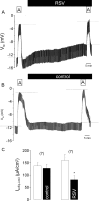
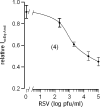
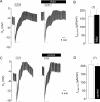
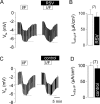
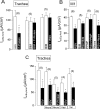
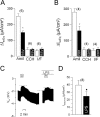
Similar articles
-
Influenza virus inhibits amiloride-sensitive Na+ channels in respiratory epithelia.Proc Natl Acad Sci U S A. 2000 Aug 29;97(18):10282-7. doi: 10.1073/pnas.160041997. Proc Natl Acad Sci U S A. 2000. PMID: 10920189 Free PMC article.
-
Matrix metalloproteinase-9 and tissue inhibitor of matrix metalloproteinase-1 in the respiratory tracts of human infants following paramyxovirus infection.J Med Virol. 2007 Apr;79(4):447-56. doi: 10.1002/jmv.20830. J Med Virol. 2007. PMID: 17311330
-
Inhibition of Na+ transport in lung epithelial cells by respiratory syncytial virus infection.Am J Respir Cell Mol Biol. 2009 May;40(5):588-600. doi: 10.1165/rcmb.2008-0034OC. Epub 2008 Oct 23. Am J Respir Cell Mol Biol. 2009. PMID: 18952569 Free PMC article.
-
Respiratory syncytial virus persistence: evidence in the mouse model.Pediatr Infect Dis J. 2008 Oct;27(10 Suppl):S60-2. doi: 10.1097/INF.0b013e3181684d52. Pediatr Infect Dis J. 2008. PMID: 18820580 Review.
-
Respiratory syncytial virus interaction with human airway epithelium.Trends Microbiol. 2013 May;21(5):238-44. doi: 10.1016/j.tim.2013.02.004. Epub 2013 Mar 22. Trends Microbiol. 2013. PMID: 23523320 Review.
Cited by
-
Purinergic signalling links mechanical breath profile and alveolar mechanics with the pro-inflammatory innate immune response causing ventilation-induced lung injury.Purinergic Signal. 2017 Sep;13(3):363-386. doi: 10.1007/s11302-017-9564-5. Epub 2017 May 26. Purinergic Signal. 2017. PMID: 28547381 Free PMC article. Review.
-
Respiratory syncytial virus inhibits lung epithelial Na+ channels by up-regulating inducible nitric-oxide synthase.J Biol Chem. 2009 Mar 13;284(11):7294-306. doi: 10.1074/jbc.M806816200. Epub 2009 Jan 8. J Biol Chem. 2009. PMID: 19131335 Free PMC article.
-
Cholesterol-rich microdomains as docking platforms for respiratory syncytial virus in normal human bronchial epithelial cells.J Virol. 2012 Feb;86(3):1832-43. doi: 10.1128/JVI.06274-11. Epub 2011 Nov 16. J Virol. 2012. PMID: 22090136 Free PMC article.
-
The host response and molecular pathogenesis associated with respiratory syncytial virus infection.Future Microbiol. 2009 Apr;4(3):279-97. doi: 10.2217/fmb.09.1. Future Microbiol. 2009. PMID: 19327115 Free PMC article. Review.
-
Ecto-5'-nucleotidase CD73 modulates the innate immune response to influenza infection but is not required for development of influenza-induced acute lung injury.Am J Physiol Lung Cell Mol Physiol. 2015 Dec 1;309(11):L1313-22. doi: 10.1152/ajplung.00130.2015. Epub 2015 Oct 2. Am J Physiol Lung Cell Mol Physiol. 2015. PMID: 26432867 Free PMC article.
References
-
- Arumugham, R. G., S. W. Hildreth, and P. R. Paradiso. 1989. Interprotein disulfide bonding between F and G glycoproteins of human respiratory syncytial virus. Arch. Virol. 105:65-79. - PubMed
-
- Bachhuber, T., J. König, T. Voelcker, B. Mürle, R. Schreiber, and K. Kunzelmann. 2005. Chloride interference with the epithelial Na+ channel ENaC. J. Biol. Chem. 280:31587-31594. - PubMed
-
- Barker, P. M., C. W. Gowen, E. E. Lawson, and M. R. Knowles. 1997. Decreased sodium ion absorption across nasal epithelium of very premature infants with respiratory distress syndrome. J. Pediatr. 130:373-377. - PubMed
-
- Barker, P. M., and R. E. Olver. 2002. Invited review: clearance of lung liquid during the perinatal period. J. Appl. Physiol. 93:1542-1548. - PubMed
-
- Boucher, R. C. 2003. Regulation of airway surface liquid volume by human airway epithelia. Pfluegers Arch. 445:495-498. - PubMed
Publication types
MeSH terms
Substances
LinkOut - more resources
Full Text Sources

